What is the E in EV?
40% of India’s three-wheelers are electric, while China dominates global EV sales

Under the UN Framework Convention on Climate Change, the government has agreed that, by 2030, of the total number of new car sales in Pakistan, 30% will be Electric Vehicles (EV) running on renewable energy whereas this number will rise to 90% by 2040.
The same is planned for the uptake of EVs in two and three wheelers, and heavy transport vehicle categories.
The first ever “National Electric Vehicles Policy” (NEVP) of Pakistan was drafted in 2019 which spells out these targets. Spearheaded by the Ministry of Climate Change, this policy was supported by other ministries, departments, the private sector, and automotive sector associations namely the Pakistan Automotive Manufacturing Association (PAMA), and Pakistan Association of Automotive Parts & Accessories Manufacturers (PAAPAM).
The 2019 NEVP chalks out the plan aimed at achieving the EV penetration targets in three phases – market development and public awareness, fuel import bill substitution, local adoption and export. The ambitious targets, however, seem nowhere close to being achieved.
Bloomberg reports that around 40% of India’s three-wheeler fleet is already electric, while China dominates the EV global sales market.
According to the Engineering Development Board, in 2021-22, a total of 322,754 cars and SUVs, and some 2,169,751 motorcycles, were manufactured in Pakistan.
The Pakistan Bureau of Statistics (PBS) states that, in 2022, the number of registered motor vehicle cars was 32 million while 34 million were on road. Of these vehicles, only a little over 8,000 are EV motorbikes. Unfortunately, the data for EV imports is not available.
One of the reasons for the low uptake of EVs is the high upfront cost. This is counter-argued by experts who opine that the low cost of energy used in the EV offsets its cost in long-term.
Poor infrastructure for renewable energy, however, makes it difficult for people to switch to EVs even if they wanted to. The only way to increase the use of EVs is through a combination of policy support, improvements in battery technology, more charging infrastructure and new compelling models from automakers.
Given rapid urbanisation, the transition to non-polluting vehicles must become a policy priority. The government has introduced tax cuts, reducing the sales tax on domestically assembled EVs, from 17% to near-zero, and tariffs on EV parts to just 1% with an aim to have 500,000 electric motorcycles and rickshaws by 2025.
What more needs to be done to increase the uptake of EVs in Pakistan will be the topic for part-II of this piece.
The question now is what energy options do we have?
Wind, hydropower, solar, geothermal, and biofuel are just some of the obvious renewable options. Although currently, only 7% of the world’s energy consumption is met by renewables, this industry has seen investments increase by 20% every year for the past decade.
To combat climate change, clean energy awareness is essential as witnessed by increasing investment. It is, however, the government’s policy support that drives growth in renewable energy.
Pakistan has pledged to increase the share of renewable sources, including hydropower, in the domestic electricity generation mix to 60%, alongside banning coal imports. It is heartening to see that the share of renewable energy in our energy mix has increased from 2.4% to 3.02% in FY2022.
According to the Climate Change Ministry, Pakistan has 37% renewable energy sources – just short of the target baseline. Pakistan does produce a fraction of its oil imports; however, it relies heavily on oil import to fuel its economy. Owing to the spike in global oil prices, coupled with the nose-diving rupee, the oil import bill has ballooned to 95.9% in FY2022 further denting the trade deficit.
Pakistan has immense potential for hydropower generation – which is around 60,000MW and only 16% exploited. Whereas, wind power potential is estimated to be 50,000 MW, accounts for 4.8% of the energy mix and is 1,985 MW.
Similarly, Pakistan has huge solar power generation potential as it is located in a tropical region. Yet it generates only 600MW electricity from solar power, which is only 1.4% of the total installed capacity.
Pakistan had commissioned 17,950 net-metering licensed systems that cumulatively accounted for 305.8 MW of distributed solar capacity. The Economist Intelligence Unit forecasts that the installed solar capacity will fall short of the draft 2022-31 IGCEP estimate of 8.4 GW, citing policy and procedural reasons.
The contribution of nuclear energy has increased to 8.8% in FY2022. With Kanupp-3 (K3) power plant (inaugurated by the prime minister on February 2, 2023) in operation, the share of nuclear energy will grow to 2200MW.
Thermal has still the largest share in electricity generation in the country, although its contribution has declined from 62.5% in FY2021 to 60.9% in FY2022.
Renewable energy has a lot of potential. Declining costs for renewable energy technologies are making them more competitive for both businesses and household operations. With cheaper technologies in place, renewable energy will keep growing in the coming years and will keep unveiling significant opportunities for businesses and investors.
In 2019, the Alternative and Renewable Energy Policy was introduced to assist and promote the development of renewable resources in the country. The main objective of the policy was to provide a supportive environment for renewable power projects and increase the share of green energy capacity. As at October 2022, 10 CPEC energy-generation projects had been completed, five more were being constructed and a further five were under consideration. Amid rising debt-related risks in Pakistan there are a lot of uncertainties regarding these projects.
Lacklustre investment in the renewables sector is due to legal hold-ups and supply-chain problems. High import controls for equipment of solar projects and vulnerability of hydropower to natural disasters are some issues.
Given that Chinese companies will finance and help build hydroelectric dams, and other renewables plants including a new nuclear reactor in Pakistan, the sector is especially sensitive to the continuation of the “all-weather” friendship.
This year’s economic growth, anticipated to be slower, could worsen the country’s circular-debt problem in the energy supply chain. The government needs to draft an appropriate action plan to harness this sector.
Shagufta Shabbar is a PhD scholar at IBA and Muhammad Akmal Javaid is a consultant at WBG
Published in The Express Tribune, February 6th, 2023.
Like Business on Facebook, follow @TribuneBiz on Twitter to stay informed and join in the conversation.



















COMMENTS
Comments are moderated and generally will be posted if they are on-topic and not abusive.
For more information, please see our Comments FAQ